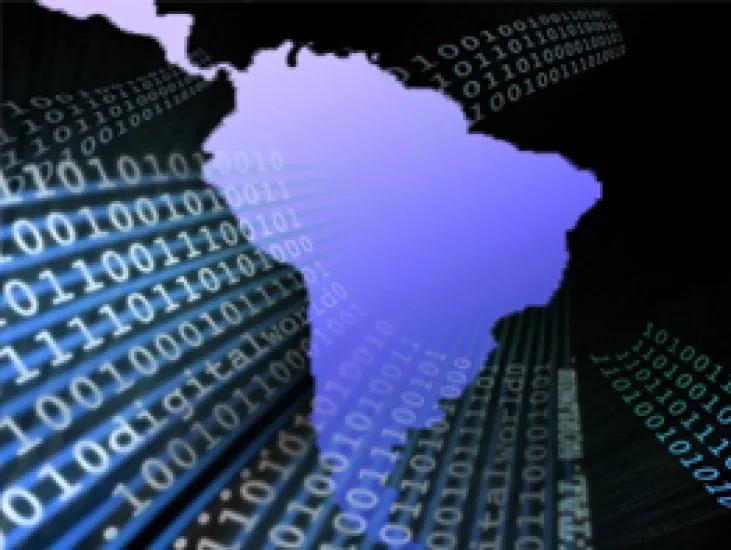After weathering through gloomy times for technology start-ups in Latin America, a handful of consumer-oriented concept companies are finally cashing in.
As consumer-spending kicks up a notch in Latin America, and more of the population rises to middle class status, technology start-ups that withstood the Internet shake-out of 2000 stand ready to tap into a new, more rational boom. Three industry veterans share their tales of survival, and how they plan to keep growing in the future.
| Marcos Galperín, CEO of MecadoLibre. |
Marcos Galperín, CEO of MercadoLibre, the world's second-largest online auction site, is in many ways the typical head of a Latin American start up. A Stanford MBA, he took advantage of business school experience to launch his company. When John Muse, co-founder of HM Capital (then known as Hicks Muse Tate & Furst) spoke at his school in 1999, Galperín asked a professor for the chance to drive the private equity king to the airport afterwards. During the drive, Galperín pitched an idea for a start-up. As he was getting out of the car, Muse told Galperín to call him. HM Capital ended up investing $5 million in Buenos Aires-based MercadoLibre's first round of capital raising.
Last year, MercadoLibre customers sold $608 million in goods sold through the website, 50% of that in Brazil. MercadoLibre charges 5% of the sale price for providing an online marketplace for those goods.
As their start-up grew, Galperín and Hernán Kazah, MercadoLibre's COO and co-founder, recruited MBAs from their alma mater to fill out senior management positions in the Internet company. Out of 13 executive team and country managers, seven are Stanford MBAs. In addition to his education, Galperín has a strong background in finance – he worked in fixed income for JPMorgan.
That financial background gave Galperín insight into what would be the most successful aspect of the then-booming dotcom market in Latin America. "Knowing that finances can dry up easily in Latin America, the Amazon model, with a large inventory, would be difficult." Galperín and Kazah settled on an online auction site, taking eBay as their model. "It was relatively easy to do as a start up," says Galperín. "It didn't need lots of investment in infrastructure." The company sped things up by using off-the-shelf software. "We needed a fast rollout" to beat competing start-ups in the same space, says Galperín, 34. "Later we developed proprietary software."
MercadoLibre now counts eBay as a partner, with the American auction behemoth having taken a 19.5% stake in the Argentine company in 2001, in exchange for eBay's Brazilian operations. MercadoLibre also ended up giving back to the company it modeled itself after. "Ebay adapted MercadoLibre's technology for it's non-English sites," notes Galperín. MercadoLibre ultimately raised $50 million in two rounds of capital raising before the boom went bust in 2001.
| Software designers creating the next "killer app" for Argentina's Core. |
A thick bankroll isn't unusual for tech start-ups. Submarino, a Brazilian company that adopted the Amazon model Galperín had dismissed as too costly, now has nearly a quarter of all the e-commerce industry in its home country. In the words of its CFO, Martín Escobari, Submarino also "raised money for a rainy day." The company prepared for so much precipitation that it would take a submarine to survive, raising $90 million between 1999 and 2000. According to Escobari, the fundraising – from such investors as TH Lee Internet Fund and GP Investimentos – paid off. "We spent 2000 through 2004 levered significantly," he says, as the company weathered the new economy downturn plus the political uncertainty that wracked Brazil leading up to the 2002 election. A focus on keeping costs down allowed Submarino muddle through the down times and lead Brazil's charge back to the equity market. In March of last year, Submarino raised $175 million in a listing on the Novo Mercado, which Escobari says helped the company pay off its debt.
One aspect of tech companies' difficulties in Latin America is that many of their products are out of the reach of most consumers in a region where per capita GDP is under $5,000 a year. This is particularly notable in Brazil, which has one of the world's highest income disparities. Pedro Bastos, a director at Unibanco Asset Management in São Paulo, says there's a silver lining to consumer-oriented companies. "It is very interesting the way the poor income distribution is very negative, but it has a positive side that people don't look at," he says. "The fact that we have a very wealthy upper middle class that are tech oriented gives Submarino an edge in growth over bricks and mortar retailers."
Escobari agrees that Submarino is focusing on the top 40% of the country for their continued growth. "In Brazil the A and B segments of the population is still 76 million people, earning over $14,000," he says, pointing out that "only 5 million of them have bought online."
Submarino credits its success to two key factors – market segmentation and relentless managerial focus on cost. "We looked for a business model that required a local solution," Escobari says, including the input of his two co-founders, Antonio Bonchristiano and Flávio Jansen, now chairman and president, respectively, as they first talked the concept over in mid-1999. Both Bonchristiano and Escobari worked at GP Investimentos, the Brazilian private equity fund that was one of the initial investors in the company. GP Investimentos no longer has a stake.
Reflecting the reality faced by anyone who has ever tried to mail a package overseas, Escobari points out that "Amazon can't compete with us from the US, but Google can."
What makes Submarino stand out from other dot-com era companies, and what makes it successful, Escobari says, is a close eye on margins. "Companies that survived the downturn were companies that focused on cost," he says. Escobari notes that his company compares favorably to online sales behemoth Amazon, which spends 8% of revenue on administration versus only 1.5% at Submarino. This combines with a large per-purchase price – an average purchase on Submarino is worth $100, on Amazon it's $20 – to give the Brazilian company a healthy profit margin. "Our per-ticket profit is $23," Escobari boasts. "Amazon's is $8."
Submarino quickly got into the black. "We became EBITDA positive after three years," says Escobari. "Amazon took five and a half years." Last year Submarino had $24.2 million in pre-tax income on $420 million in revenue.
In the past 18 months the company has looked to expand the Submarino brand. This is being done through acquisitions and the launch of new products. In the third quarter of last year, the company bought Ingresso, an online movie ticket sales company. "Ingresso was bought as a source of frequency and lots of data," says Escobari. Earlier this year, they also bought an online travel-booking site, Viagens.
| Martín Escobari, CFO at Submarino. |
Core Security Technology
Not every successful start-up is backed by a squad of B-school bombers. "It's better not to have an MBA in Argentina," says Ivan Arce, chief technology officer of Core Security Technology, a security software design firm. "Start-ups in Argentina require flexibility & thinking outside the box – street smarts. You don't learn those in business school."
Thirty-six-year-old Arce, one of the six cofounders of Core, is wry about his company's origins. "We didn't know what we were doing," he laughs from Core's Buenos Aires development center, from which 75 of Core's 100 employees work on software for clients. "What we were trying to do is work on things we were passionate about, and maybe make a living." The six computer programmers began working together in 1996 out of a spare room in Arce's house. At 26, Arce was the oldest of the group.
Core didn't consider outside investment until Jonathan Altszul, one of the founders and current chairman of the company, was selected as entrepreneur of the year in 2000 by Endeavor, a non-profit headquartered out of New York that promotes entrepreneurship. Pegasus Capital first invested, and last year Morgan Stanley Venture Partners invested $4.5 million in the privately held company. Core's success stems from not having to depend on the fickleness of the Argentine economy to supply it with customers. After working on an initial project for the Argentine tax authority, Core turned to North American companies, first taking on the local branch of BankBoston and then the Canadian technology firm Secure Networks. Now Core is headquartered in Boston and has a diverse client list, including Brazilian energy concern Petrobras, phone company AT&T and financial group JPMorgan.
| Ivan Arce, chief technology officer at Core. |
The fragmentation of Latin America into 34 economies makes it tough for a company to expand regionally. Arce says it's not just economic, but also cultural: "Latin Americans do not trust technology companies from fellow Latin Americans." Arce characterizes as the typical Latin American corporate consumer attitude like so: "If it's from the US, Europe or China, you know it's good. But if it's built by the guy next door, you react as 'I know that guy – I don't trust him.'"






